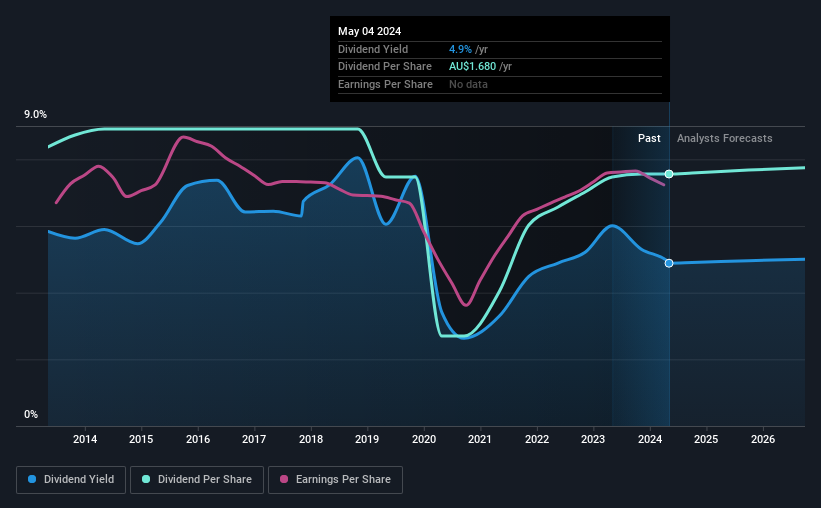National Australia Bank (ASX:NAB) Is Due To Pay A Dividend Of A$0.84
National Australia Bank Limited (ASX:NAB) has announced that it will pay a dividend of A$0.84 per share on the 3rd of July. The payment will take the dividend yield to 4.9%, which is in line with the average for the industry.
See our latest analysis for National Australia Bank
National Australia Bank's Dividend Forecasted To Be Well Covered By Earnings
Unless the payments are sustainable, the dividend yield doesn't mean too much.
Having distributed dividends for at least 10 years, National Australia Bank has a long history of paying out a part of its earnings to shareholders. Based on National Australia Bank's last earnings report, the payout ratio is at a decent 75%, meaning that the company is able to pay out its dividend with a bit of room to spare.
The next 3 years are set to see EPS grow by 9.0%. Analysts forecast the future payout ratio could be 72% over the same time horizon, which is a number we think the company can maintain.
Dividend Volatility
The company has a long dividend track record, but it doesn't look great with cuts in the past. Since 2014, the annual payment back then was A$1.86, compared to the most recent full-year payment of A$1.68. Doing the maths, this is a decline of about 1.0% per year. Generally, we don't like to see a dividend that has been declining over time as this can degrade shareholders' returns and indicate that the company may be running into problems.
The Dividend's Growth Prospects Are Limited
Given that the dividend has been cut in the past, we need to check if earnings are growing and if that might lead to stronger dividends in the future. Although it's important to note that National Australia Bank's earnings per share has basically not grown from where it was five years ago, which could erode the purchasing power of the dividend over time. Earnings are not growing quickly at all, and the company is paying out most of its profit as dividends. When a company prefers to pay out cash to its shareholders instead of reinvesting it, this can often say a lot about that company's dividend prospects.
In Summary
Overall, this is a reasonable dividend, and it being raised is an added bonus. The dividend has been at reasonable levels historically, but that hasn't translated into a consistent payment. Taking all of this into consideration, the dividend looks viable moving forward, but investors should be mindful that the company has pushed the boundaries of sustainability in the past and may do so again.
Market movements attest to how highly valued a consistent dividend policy is compared to one which is more unpredictable. Meanwhile, despite the importance of dividend payments, they are not the only factors our readers should know when assessing a company. For instance, we've picked out 1 warning sign for National Australia Bank that investors should take into consideration. If you are a dividend investor, you might also want to look at our curated list of high yield dividend stocks.
Have feedback on this article? Concerned about the content? Get in touch with us directly. Alternatively, email editorial-team (at) simplywallst.com.
This article by Simply Wall St is general in nature. We provide commentary based on historical data and analyst forecasts only using an unbiased methodology and our articles are not intended to be financial advice. It does not constitute a recommendation to buy or sell any stock, and does not take account of your objectives, or your financial situation. We aim to bring you long-term focused analysis driven by fundamental data. Note that our analysis may not factor in the latest price-sensitive company announcements or qualitative material. Simply Wall St has no position in any stocks mentioned.

 Yahoo Finanza
Yahoo Finanza 
